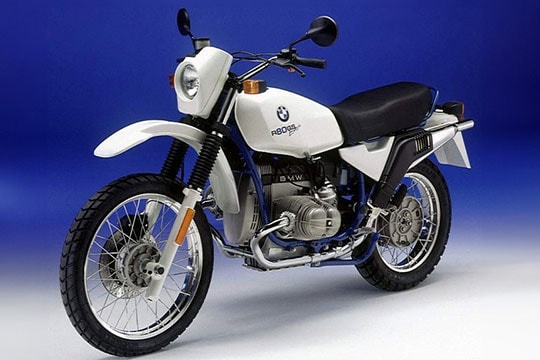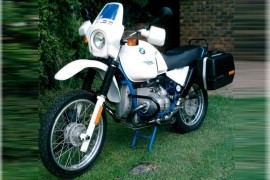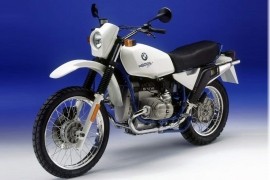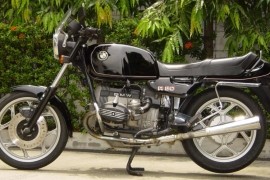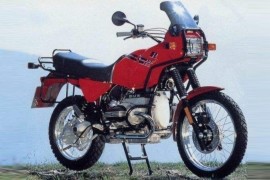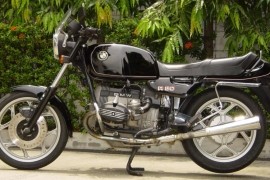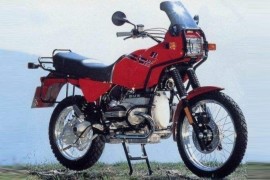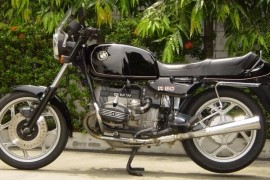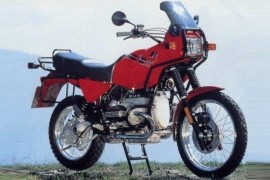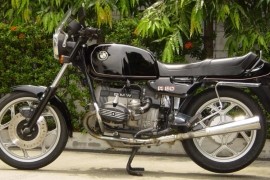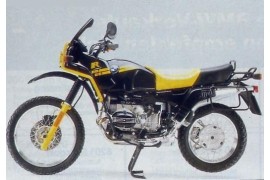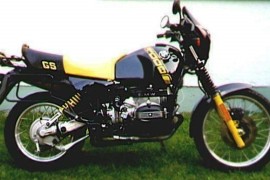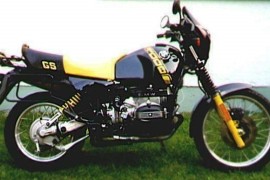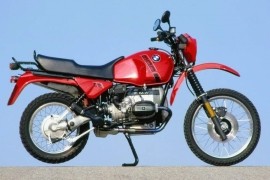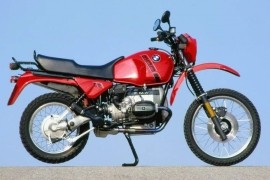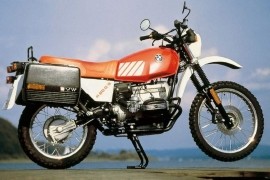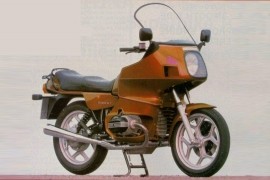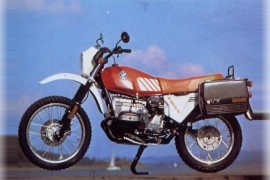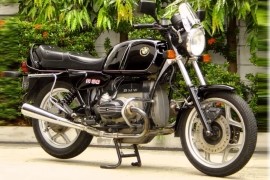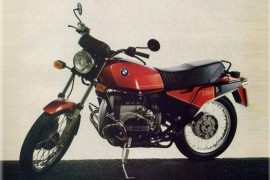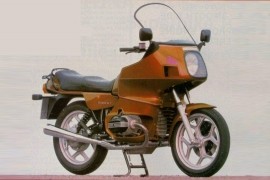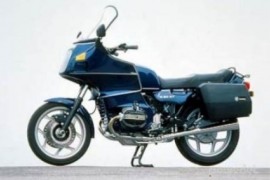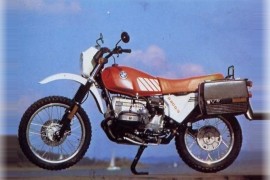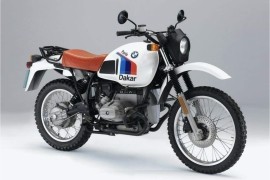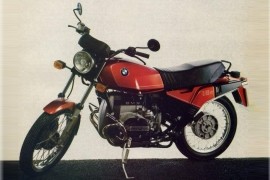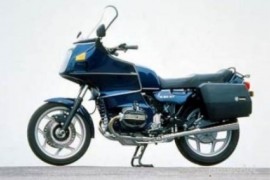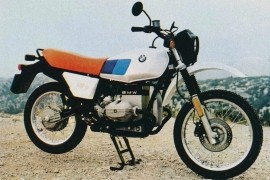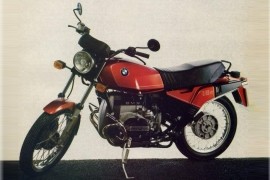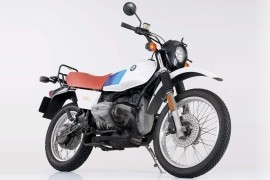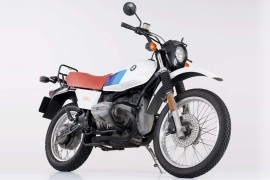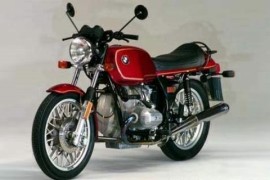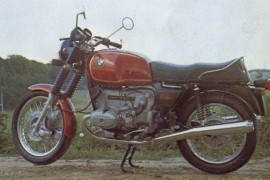BMW R 80 Models/Series Timeline, Specifications & Photos
First production year: 1977
In 1997, the German motorcycle manufacturer launched the BMW R 80 GS Basic, the ultimate model with the old, cooled flathead. The bike was sold in a white and blue frame, a high-mounted front fender, and a White Power rear shock.
Visually, the motorcycle packed standard features, such as a high-mounted front fender, a small round headlight integrated into a small cowl, a one-piece dual seat with a passenger grab rail, a high-mounted exhaust system, a single-sided swingarm, and wire-spoke wheels.
The motorcycle was built around a double-loop tubular steel frame with a 40 mm Marzocchi telescopic fork on the front that provided 225 mm of travel and a BMW Motorrad Paralever swingarm on the rear with 180 mm of travel.
Braking-wise, the bike's wire-spoke wheels were fitted with a single 285 mm brake disc on the front and a 200 mm drum braking unit on the rear, delivering optimum stopping power.
The 1997 BMW R 80 GS Basic was powered by a 797cc four-stroke air-cooled twin-cylinder boxer engine mounted underneath its fuel tank, delivering an output power of 50 hp at 6,500 rpm and 61 Nm (45 lb-ft) torque at 5,000 rpm.
The engine's power was redirected to the rear end via a five-speed manual transmission and a final shaft drive that spun the rear wheel to a top speed of 170 kph (106 mph).
In 1997, the German motorcycle manufacturer launched the BMW R 80 GS Kalahari in South Africa. It was based on the Base R 80 GS available in Europe and came with a blue frame and white color scheme.
The bike addressed riders who wanted a more adventurous machine that could tackle the most treacherous terrains possible but also wanted a motorcycle capable of trivial tasks, such as daily commuting.
In the aesthetic department, the bike had standard fittings, such as a high-mounted front fender, a round headlight upfront, a wind deflector, hand guards, a one-piece dual seat with passenger grab rails, a center stand, and wire-spoke wheels.
It was built around a double-loop tubular steel frame with a 40 mm Marzocchi telescopic fork on the front that delivered 225 mm of travel and a BMW Motorrad Paralever system on the rear with 180 mm of travel.
As for the braking power, the motorcycle's wheels were fitted with a single 285 mm brake disc on the front and a 200 mm drum braking unit on the rear, offering optimum stopping power.
In the performance department, the 1997 BMW R 80 GS Kalahari had its soul brought to life by a 797cc four-stroke air-cooled twin-cylinder boxer engine that delivered an output power of 50 hp at 6,500 rpm and 61 Nm (45 lb-ft) torque at 5,000 rpm.
In 1996, BMW released the R 80 GS as the last twin-valve Boxer motorcycle and as a homage to the R 80 G/S. From the headlamp and speedometer through the tank and seat all the way back to the frame tail, the R 80 GS basic had the same visual profile as the R 80 G/S.
The main frame with the engine and the chassis technology with the brakes came from the last R 80 GS that had the latest Paralever chassis and cross-spoke wheels.
The 1996 BMW R 80 GS Basic was taking its trust from a 979cc flat-twin engine with a power output of 50 hp at 6,500 rpm and 61 Nm (45 lb-ft) of torque with a peak at 5,000 rpm that pushed the bike to a top speed of 168 kph (104 mph).
On the front wheel was a telescopic fork with hydraulic shock absorbers with a 285 mm brake disc, and on the rear was a BMW Paralever single-sided swingarm with a monoshock absorber and a 200 mm brake drum unit.
The basic came from the factory in a blue finished frame with white components and with standard features such as a dual seat, passenger grab rails, a high-mounted exhaust system, laced wheels, an analog instrumentation panel, and a side stand.
The 1994 MY BMW R 80 R boasts a maximum power output of 50 horsepower and 61 Nm of torque from its four-stroke, air-cooled, boxer twin cylinder engine, that is paired to a five-speed manual transmission with a low-maintenance shaft final drive.
Also, this naked two-wheeler has standard fittings such as a front disc brake coupled to a rear drum, die-cast aluminium wheels, a dual seat, passenger grab rails, a dual exhaust system, a large-capacity 24-liter (6.3-gallon) fuel tank, engine guards, a small windscreen, an analogue instrument cluster and a suspension package composed of a telescopic front fork and a BMW Motorrad Paralever unit in the rear.
The 1994 MY BMW R 80 GS sports an air-cooled, four-stroke, 797cc, boxer twin cylinder powerplant paired to a five-speed manual transmission that can produce a claimed 50 horsepower and 61 horsepower. Standard features include a dual seat, laced wheels, a small luggage rack in the rear, pillion grab rails, an analogue instrument cluster, a blacked-out, steel frame, a 40mm Marzocchi telescopic front fork and a Paralever rear suspension, plus a braking system composed of a front disc and a rear drum.
If you are on the market for a middle-weight naked, capable of tackling both the busy traffic of the urban jungle, as well as longer, weekend strolls in the mountains or across the countryside. It has, at its heart, an air-cooled, four-stroke, 797cc, boxer twin cylinder powerplant paired to a five-speed manual transmission that can reach a maximum power output of 50 horsepower and 61 Nm of torque.
In addition, it comes with a front disc brake coupled to a rear drum, die-cast aluminium wheels, a dual seat, passenger grab rails, a dual exhaust system, a large-capacity 24-liter (6.3-gallon) fuel tank, engine guards, a small windscreen, an analogue instrument cluster and a suspension package composed of a telescopic front fork and a BMW Motorrad Paralever unit in the rear.
If you are on the market for a gritty yet agile and fuel-efficient all-road vehicle, then the 1993 MY BMW R 80 G/S may be the right choice for you. It boasts a maximum power output of 50 horsepower and 61 Nm of torque from its air-cooled, four-stroke, 797cc, boxer twin cylinder engine.
Also, it comes with a dual seat, laced wheels, a small luggage rack in the rear, pillion grab rails, an analogue instrument cluster, a blacked-out, steel frame, a 40mm Marzocchi telescopic front fork and a Paralever rear suspension, plus a braking system composed of a front disc and a rear drum.
In 1992, at the request of several export markets in Europe, BMW launched the R 80 R, a smaller roadster motorcycle version of the BMW R 100 R. Due to the modified framework conditions in Switzerland, where the 1000cc twin-valve motorcycles were no more marketed, the smaller R 80 R, with an 800cc engine and lower emissions, was a perfect fit and passed through the registration barriers.
The model came in two versions, one with an output power of 50 hp and a version with 27 hp, which was suitable for beginner riders and motorcycle schools.
The difference between the R 80 R and R 100 R, besides the smaller engine, was the lack of an oil cooler that on the 1000 series was given as standard. In other aspects, such as the chassis, frame, brakes, and design, it was identical to its bigger sister.
The rear wheel spinning power came from the 797cc flat-twin engine that produced an output power of 50 hp with a peak at 6,500 rpm and 61 Nm (45 lb-ft) of torque available at 3,750 rpm. Due to a curb weight of 217 kg (478 lbs) and a five-speed manual transmission, the bike registered a top speed of 168 kph (105 mph).
The naked machine came with standard features such as cast aluminum wheels, a dual seat, passenger grab rails, a small windscreen, an analog instrument cluster, a dual exhaust system, and a center stand.
The 1992 MY BMW R 80 G/S is one of the most versatile machines from the House of Munich, and is sure to fit the taste for a wide variety of riders. It boasts standard fittings such as a dual seat, laced wheels, a small luggage rack in the rear, pillion grab rails, an analogue instrument cluster, a blacked-out, steel frame, a 40mm Marzocchi telescopic front fork and a Paralever rear suspension, plus a braking system composed of a front disc and a rear drum.
In addition, it comes with an air-cooled, four-stroke, 797cc, boxer two cylinder engine mated to a five-speed manual transmission that can produce a claimed 50 horsepower and 71 Nm of torque.
The 1991 MY BMW R 80 R has, at its heart, an air-cooled, four-stroke, 797cc, boxer twin cylinder engine paired to a five-speed manual transmission, that reaches a maximum power output of 50 horsepower and 61 Nm of torque.
Standard fittings for this naked two-wheeler include a front disc brake coupled to a rear drum, die-cast aluminium wheels, a dual seat, passenger grab rails, a dual exhaust system, a large-capacity 24-liter (6.3-gallon) fuel tank, engine guards, a small windscreen, an analogue instrument cluster and a suspension package composed of a telescopic front fork and a BMW Motorrad Paralever unit in the rear.
In 1991, BMW released the R 80 GS alongside the R 100 GS, two enduro motorcycles that received a comprehensive facelift, noticeable through the new look. As standard, both models had semi-fairing bolted to the frame and external tubular bars derived from the cockpit fairing of the R 100 GS Paris-Dakar from 1989.
Visually, instead of the round headlight, the model packed a rectangular lamp taken from the K 75 S model. The instrument panel was integrated into the fairing, modified with two round instruments of the same size, and benefited from a rev counter. The windshield received a different shape and came tinted from the factory.
In addition, the handlebar controls were replaced with the K model controls, which featured turn signal actuation, and the safety tank cap from the /7 series was installed but reduced the fuel volume by two liters.
The 1991 BMW R 80 GS was taking its trust from a 797cc flat-twin engine with a power output of 50 hp at 6,500 rpm and 61 Nm (45 lb-ft) of torque available at 5,000 rpm. With a curb weight of 215 kg (474 lbs), the bike reached a top speed of 168 kph (105 mph).
It also came with standard features such as a dual seat, laced wheels, a small luggage rack on the rear, pillion grab rails, an analog instrument cluster, a blacked-out steel frame, and a center stand.
The 1990 MT BMW R 80 G/S addresses the more adventurous among Beemer fans, and comes with a dual seat, laced wheels, a small luggage rack in the rear, pillion grab rails, an analogue instrument cluster, a blacked-out, steel frame, a 40mm Marzocchi telescopic front fork and a Paralever rear suspension, plus a braking system composed of a front disc and a rear drum.
In the engine department, it sports a four-stroke, air-cooled, 797cc, boxer twin cylinder powerplant mated to a five-speed manual transmission that can produce a claimed 50 horsepower and 61 Nm of torque.
The 1989 MY BMW R 80 G/S has, at its heart, a four-stroke, air-cooled, 797cc, boxer twin cylinder engine paired to a five-speed manual transmission and can reach a maximum power output of 50 horsepower and 61 Nm of torque.
In addition, it boasts standard features such as a dual seat, laced wheels, a small luggage rack in the rear, pillion grab rails, an analogue instrument cluster, a blacked-out, steel frame, a 40mm Marzocchi telescopic front fork and a Paralever rear suspension, plus a braking system composed of a front disc and a rear drum.
The House of Munich has designed the BMW R 80 G/S especially for those riders who want a powerful yet agile two-wheeler, capable of tackling the busy traffic of the urban jungle, longer strolls across the countryside and even light off-road tracks. It sports an air-cooled, four-stroke, 797cc, boxer two cylinder powerplant mated to a five-speed manual transmission and can produce a claimed 50 horsepower and 57 Nm of torque.
Also, standard fittings include laced wheels, a dual seat, a small luggage rack in the rear, pillion grab rails, an analogue instrument cluster, a blacked-out, steel frame, a 40mm Marzocchi telescopic front fork and a Paralever rear suspension, plus a braking system composed of a front disc and a rear drum.
In 1987, BMW launched the R 80 GS and R 100 GS, a new generation of large-touring Enduro motorcycles that shared the same Paralever suspension on the rear wheel, a 26-liter fuel tank, a new telescopic fork on the front, and an enlarged frame tail.
A safety feature that also increased the off-road and on-road performance was the cross-spoke wheels dressed in tubeless tires, which was a first for this kind of wheels and eventually became an integral part of the BMW boxer and K models generations.
The 1987 BMW R 80 GS, with its 797cc flat-twin engine known from the G/S, produced a power output of 50 hp at 6,500 rpm and 61 Nm (45 lb-ft) of torque with a peak at 5,000 rpm. The engine power, combined with a five-speed manual transmission and a 210 kg (463 lbs) curb weight, resulted in a maximum speed of 168 kph (105 mph).
For suspension, the model packed a new Marzocchi telescopic fork with a hydraulic shock absorber on the front and BMW Paralever single-sided swingarm with a central spring strut on the rear wheel.
The off-road-sport machine came with standard features such as laced wheels, a dual seat, a small luggage rack on the rear, pillion grab rails, an analog instrument cluster, a blacked-out steel frame, and a center stand.
The BMW R 80 G/S was a dual-sports motorcycle produced by BMW in Berlin, Germany, from 1980 to 1987. Over its production time, the maker manufactured over 21,800 motorcycles. The bike's G/S designations represent the German words Gelande/Strasse, which translates to off-road/road.
In addition, the R 80 G/S was the first motorcycle in BMW's G/S range of dual-sports motorcycles, which comprised over 500,000 produced units. Also, the motorcycle was often considered the world's first "Adventure Bike" capable of tackling both on and off-road conditions.
In 1985, the German motorcycle manufacturer launched the BMW R 80 G/S, a dual-sports motorcycle in its sixth consecutive production year that featured the same package. Over its production time, the bike remained largely unchanged, offering the same specifications without significant changes.
In the aesthetic department, the motorcycle had standard fittings, a round headlight placed into a small cowl, a one-piece dual seat with passenger grab rails, a small luggage rack, a center stand, a high-mounted front fender, and wire-spoke wheels.
As for the power figures, the 1985 BMW R 80 G/S boasted 50 hp with maximum strength at 6,500 rpm and 57 Nm (42 lb-ft) torque at 5,000 rpm from a 797cc four-stroke air-cooled twin-cylinder boxer engine fed by two Bing carburetors.
The power generated by the engine was transferred to a five-speed transmission and sent to the rear end via a final shaft drive, pushing the motorcycle to a top speed of 167 kph (104 mph).
In 1984, the German maker released the BMW R 80 RT, a new addition to the mid-range tourer range, which retained the frame concept from the R 80 with a single-sided swingarm, wheels, and brakes.
The extensive innovations of the RT with the large touring fairing had a clear effect and made the new version more active than the previous model with the R 100 RT chassis.
Due to the Monolever suspension, the R 80 RT had a reduced curb weight of 227 kg (500 lbs), and a modified engine tuning with a new exhaust system made the model livelier than its predecessor.
In the visual department, the 1984 BMW R 80 RT Mono had a new front mudguard, side covers, and seat that played a good part and made the model look more dynamic and younger than its predecessor.
The thrust came from a 797cc flat-twin engine that delivered an output power of 50 hp at 6,500 rpm and 60 Nm (44 lb-ft) of torque with a peak at 3,500 rpm. A five-speed transmission sent the power to the rear wheel through a final shaft drive, pushing the bike to a top speed of 170 kph (106 mph).
As standard features, the bike came with a one-piece dual seat, a passenger grab handles, a large windscreen, a half-fairing for increased protection against the elements, laced wheels, dual front 285 mm disc brakes coupled to a 200 mm rear drum unit, an analog instrument panel, and a center stand.
In 1984, the German motorcycle maker released the BMW R 80 G/S, a dual-purpose motorcycle, in its fifth consecutive production year. Like the previous one, the 1984 model packed the same specifications without any changes.
The BMW R 80 G/S was a dual-sports bike produced by BMW in Berlin, Germany, from 1980 to 1987. Over its production period, the maker manufactured over 21,800 motorcycles. The bike's G/S designations represent the German words Gelande/Strasse, which translates to off-road/road.
The R 80 G/S was the first motorcycle in BMW's G/S family of dual-sports motorcycles, which comprised over 500,000 produced units. In addition, the motorcycle was often considered the world's first "Adventure Bike" capable of tackling both on and off-road conditions.
The bike's visual department was characterized by standard features, such as a round headlight placed into a small cowl, a one-piece dual seat with passenger grab rails, a small luggage rack, a center stand, a high-mounted front fender, and wire-spoke wheels.
It was made around a double-loop tubular steel frame with a bolt-on rear section that comprised a hydraulic telescopic fork with 200 mm travel on the front and a monolever swingarm on the rear with 170 mm of travel.
As for power, the 1984 BMW R 80 G/S was set in motion by a 797cc four-stroke air-cooled twin-cylinder boxer engine mounted underneath its fuel tank, delivering an output power of 50 hp with maximum strength at 6,500 rpm and 57 Nm (42 lb-ft) torque at 5,000 rpm.
The 1985 MY BMW R 80 Mono has, at its heart, an air-cooled, four-stroke, 797cc, boxer twin cylinder powerplant paired to a five-speed manual transmission, and can reach a maximum power output of 50 horsepower and 58 Nm of torque.
In addition, it is one of the first machines from the House of Munich to be equipped with the Monolever rear suspension system, which improves comfort and overall performance significantly. Other features include a telescopic front fork, laced wheels, a single front disc brake coupled to a rear drum, a dual seat, pillion grab rails, die-cast aluminium wheels, an analogue instrument cluster and a steel, black frame.
In 1983, the German motorcycle maker released the BMW R 80 ST, a road-oriented motorcycle in its second production year. The model came in the same shape and form as the previous model, without any modifications.
The bike had several technical road-use adjustments, including a 19-inch front wheel, road tires, and a shorter suspension travel, significantly increasing ground clearance.
The bike was manufactured from 1982 until 1984 in just 5,953 units. It was not to the taste of BMW buyers and remained a niche model with no direct successor. It was later followed by the BMW R 80 Monolever and BMW R 100 R with a paralever system.
Visually, the bike had standard features, such as a round headlight on the front, a one-piece dual seat, a passenger grab handle, a side stand, a single-sided swingarm, and wire-spoke wheels with road tires.
In the performance department, the 1983 BMW R 80 ST had its soul brought to life by a 797cc four-stroke air-cooled twin-cylinder boxer engine that delivered an output power of 50 hp at 6,500 rpm and 58 Nm (43 lb-ft) torque at 5,000 rpm.
The power generated by the engine was handled by a five-speed manual transmission with a dry single-plate clutch that redirected the power to the rear wheel via a final shaft drive, launching the bike to a top speed of 171 kph (106 mph).
In 1985, the German motorcycle manufacturer released the BMW R 80 RT Mono, a touring motorcycle that debuted in 1984 with the new Monolever system. Like the R 80 RT standard model, the R 80 RT Mono was manufactured for only two years.
The 1985 model came with the same package as the previous one, delivering the same technical, performance, and visual specifications without any significant modifications whatsoever.
The bike was built around a steel frame with a hydraulic telescopic fork on the front that delivered 200 mm of travel and a single-sided swingarm with a right-hand side-mounted shock absorber that provided 125 mm of travel.
As for the braking power, the motorcycle rolled on aluminum alloy wheels with two 260 mm brake discs mounted on the front engaged by a single-piston caliper and a single 200 mm drum braking unit on the rear.
Aesthetically, the motorcycle had standard features, such as a full fairing with a round headlight, a large windscreen for better protection, a one-piece dual seat with a passenger grab rail, a two-into-two exhaust system with a silencer on each side, a center stand, and aluminum alloy wheels.
Underneath its fuel tank, the 1984 BMW R 80 RT Mono had installed a 797cc four-stroke twin-cylinder air-cooled engine that delivered an output power of 50 hp at 6,500 rpm and 60 Nm (44 lb-ft) torque at 3,500 rpm.
In 1983, the German motorcycle manufacturer released the BMW R 80 RT, a touring motorcycle that debuted in 1982 and continued production until 1995. From 1984 to 1995, the bike featured a Monolever system on the rear.
The 1983 model was in its second production year and came with the same package as the previous one, delivering the same technical, visual, and performance specifications without significant changes.
The bikes manufactured from 1982 to 1984 were a slimmed version of the R 100 RT. Some differences between the 80 RT and 100 RT included a single color paint job without typical black edges, no paint on the cylinder covers, the cylinder crash bar was special accessories, as well as the suitcase holder, and a drum brake instead of a disc brake on the rear wheel.
The bike was equipped with standard features in the visual department, such as a full fairing, a large windscreen, a one-piece dual seat with a passenger grab handle, a small luggage rack, a dual exhaust system with a silencer mounted on each side, and multi-spoke aluminum wheels.
In the performance department, the 1983 BMW R 80 RT had its soul brought to life by a 797cc four-stroke air-cooled twin-cylinder boxer engine that delivered an output power of 50 hp at 6,500 rpm and 60 Nm (44 lb-ft) torque at 3,500 rpm.
The BMW R 80 G/S was a dual-sports machine made by BMW in Berlin, Germany, from 1980 to 1987. Over its production period, the maker made over 21,860 motorcycles. The bike's G/S designations represent the German words Gelande/Strasse, which translates to off-road/road.
In 1983, the German motorcycle manufacturer released the BMW R 80 G/S, a powerful all-purpose two-wheeler created by the House of Munich for those riders searching for a motorcycle suited for both on and off-road trails.
The 1983 motorcycle came in the same shape and form as previous models, delivering the same technical, performance, and visual specifications without any significant changes whatsoever.
The bike's aesthetic department was characterized by standard fittings, such as a round headlight integrated into a small cowl, a one-piece dual seat with passenger grab rails, a small luggage rack, a center stand, a high-mounted front fender, and wire-spoke wheels.
As for the power figures, the 1982 BMW R 80 G/S was set in motion by a 797cc four-stroke air-cooled twin-cylinder boxer engine mounted underneath its fuel tank, boasting 50 hp with maximum strength at 6,500 rpm and 57 Nm (42 lb-ft) torque at 5,000 rpm.
The R 80 G/S was the first motorcycle in BMW's G/S range of dual-sports motorcycles, which comprised over 500,000 produced units. In addition, the bike was often considered the world's first "Adventure Bike" capable of tackling both on and off-road conditions.
The BMW R 80 G/S was a dual-sports motorcycle created by BMW from 1980 to 1987. It was the first dual-sports motorcycle in the BMW GS family, which comprised over 500,000 motorcycles. From 1980 to 1987, the maker produced over 21,800 R 80 G/S units.
In 1984, the German motorcycle manufacturer launched the BMW R 80 G/S Paris Dakar, a more off-road-oriented version of the base model, manufactured in 200 units. The bike was slightly tweaked to deliver the best possible performance, safety, and comfort.
Unlike the standard models, the Paris Dakar version came with a single seat, a luggage rack on the rear, an under-seat exhaust system, knobby tires mounted on wire-spoke wheels, and an extra-large 32-liter (8.4-gallon) fuel tank. The bike had the same specs as the base model in other departments.
Underneath its fuel tank, the 1984 BMW R 80 Paris Dakar had installed a 797cc four-stroke twin-cylinder air-cooled boxer engine that delivered an output power of 50 hp at 6,500 rpm and 57 Nm (42 lb-ft) torque at 5,000 rpm.
It was built around a double-loop tubular steel frame, packing a telescopic fork on the front with 200 mm of travel and a monolever swingarm on the rear with 170 mm travel.
For stopping power, the bike's wheels were fitted with a 260 mm brake disc on the front and a 200 mm drum braking unit on the rear.
In 1980, the BMW R 80 G/S was launched and well-received by the public, and even Das Motorrad magazine stated that the G/S was the best Enduro motorcycle ever built by BMW. After the success of the G/S, BMW joined with a street version alongside the G/S in 1982.
The 1982 BMW R 80 ST, where ST stands for road, adopted the concept of the successful model with an 800cc engine and borrowed the frame from the R 65 model along with its single-sided swingarm and the raised exhaust system.
The model had shortened suspension for road use, the front was guided by a smaller 19-inch wheel, and normal road tires were mounted. From the R45 and R 65 LS series, the bike featured a low front mudguard, the cockpit, and a round headlight.
In the power department, the R 80 ST heartbeat was set by the 797cc flat-twin engine with a power output of 50 hp at 6,500 rpm and 57 Nm (42 lb-ft) of torque with a peak at 5,000 rpm. It was tied to a five-speed manual transmission, delivering the power to the rear wheel through a final shaft drive, pushing the bike to a top speed of 174 kph (107 mph).
The model had standard features such as laced wheels, a dual seat, a blacked-out steel frame, lower handlebars, crash guards, and a side stand.
The BMW R 80 RT was a touring motorcycle created by BMW from 1982 to 1995, powered by a two-cylinder four-stroke boxer engine. From 1984, the bike was made with a monolever system on the rear. In addition, from 1982 to 1995, the maker produced over 29,350 units.
The bikes manufactured from 1982 to 1984 were a slimmed version of its larger sister, the R 100 RT. Some differences between the 80 RT and 100 RT included a single color paint job without typical black edges, no paint on the cylinder covers, the cylinder crash bar was special accessories, as well as the suitcase holder, and a drum brake instead of a disc brake on the rear wheel.
The bike's aesthetic department was characterized by standard features, such as a full fairing, a large windscreen, a one-piece dual seat with a passenger grab handle, a small luggage rack, a dual exhaust system with a silencer mounted on each side, and multi-spoke aluminum wheels.
As for the power figures, the 1982 BMW R 80 RT had installed a 797cc four-stroke air-cooled twin-cylinder boxer engine that delivered an output power of 50 hp at 6,500 rpm and 60 Nm (44 lb-ft) torque at 3,500 rpm.
The power was redirected to the rear wheel through a five-speed manual transmission and a final shaft drive, launching the motorcycle to a top speed of 171 kph (106 mph).
In 1982, the German motorcycle manufacturer released the BMW R 80 G/S, a dual sport machine that debuted in 1980 and continued production until 1987. Between 1980 and 1987, the German maker produced over 21,800 units.
The 1982 model came in the same shape and form as the previous one, providing the same technical, visual, and performance specifications without any significant modifications whatsoever.
The R 80 G/S was the first motorcycle in BMW's G/S family of dual-sports motorcycles, which comprised over 500,000 produced units. In addition, the bike was often considered the world's first "Adventure Bike" capable of tackling both on and off-road conditions.
Visually, the bike had standard features, such as a round headlight into a small cowl, a one-piece dual seat with passenger grab rails, a small luggage rack, a center stand, a high-mounted front fender, and wire-spoke wheels.
The bike was manufactured around a double-loop tubular steel frame with a bolt-on rear section that comprised a hydraulic telescopic fork with 200 mm travel on the front and a monolever swingarm on the rear with 170 mm of travel.
In the performance department, the 1982 BMW R 80 G/S had installed a 797cc four-stroke air-cooled twin-cylinder boxer engine underneath its fuel tank, delivering an output power of 50 hp with maximum strength at 6,500 rpm and 57 Nm (42 lb-ft) torque at 5,000 rpm.
The BMW R 80 ST was the road-oriented sister of the BMW R 80 G/S travel enduro. It was manufactured from 1982 until 1984 and featured several adjustments to be used on the road, like a 19-inch front wheel, road tires, and a shorter suspension travel, significantly increasing ground clearance.
In 1984, the German motorcycle maker released the BMW R 80 ST, a road motorcycle in its third and last year of production. It didn't have a direct successor but was later followed by the BMW R 80 Monolever and BMW R 100 R with a Paralever system.
The 1984 motorcycle came with the same package as the previous model, featuring the same technical, visual, and performance specifications without any modifications whatsoever.
Visually, the motorcycle had standard fittings, like a round headlight on the front, a one-piece dual seat, a passenger grab handle, a side stand, a single-sided swingarm, and wire-spoke wheels with road tires.
As for the power figures, the 1984 BMW R 80 ST was powered by a 797cc four-stroke air-cooled twin-cylinder boxer engine mounted at its core that delivered an output power of 50 hp at 6,500 rpm and 58 Nm (43 lb-ft) torque at 5,000 rpm.
The engine was married to a five-speed transmission that transmitted the power from the engine to the rear end via a final shaft drive, pushing the motorcycle to a top speed of 171 kph (106 mph).
The BMW R 80 G/S was a dual-sports motorcycle manufactured by BMW in Berlin, Germany, from 1980 to 1987. Over its production period, the maker made over 21,860 motorcycles. The bike's G/S designations represent the German words Gelande/Strasse, which translates to off-road/road.
The R 80 G/S was the first motorcycle in BMW's GS family of dual-sports motorcycles, which comprised over 500,000 produced units. In addition, the bike was often considered the world's first "Adventure Bike" capable of tackling both on and off-road conditions.
In 1981, the German motorcycle manufacturer released the BMW R 80 G/S, an adventure motorcycle in its second production year. The bike came in the same shape and form as the previous one without significant changes.
The bike was made around a double-loop tubular steel frame with a bolt-on rear section that comprised a hydraulic telescopic fork with 200 mm travel on the front and a monolever swingarm on the rear with 170 mm of travel.
As for the braking power, the motorcycle's wheels were fitted with a single 260 mm brake disc on the front and a 200 mm drum braking unit on the rear, offering optimum stopping power.
The 1981 BMW R 80 G/S had its soul brought to life by a 797cc four-stroke air-cooled twin-cylinder boxer engine that delivered 50 hp with maximum strength at 6,500 rpm and 57 Nm (42 lb-ft) torque at 5,000 rpm.
At the end of the 1970s, when the motorcycle business went rough on BMW, with sales of the 1000cc boxer stagnating and the new smaller series not returning enough profit, the BMW Motorrad management department decided to manufacture an off-road boxer motorcycle that also handles the road.
After just one year and nine months of development, the result was the 1980 BMW R 80 G/S which entered the market as the Enduro motorcycle with the largest displacement engine and the biggest amount of horsepower.
For the G/S model, BMW combined proven components such as a well-balanced 800cc engine, the frame of the R 65 model, a robust cardan drive, and an off-road chassis, and for the first time on a production motorcycle, BMW used a single-sided swingarm to guide the rear wheel.
The momentum energy of the bike came from the 797cc flat-twin engine with a power output of 50 hp at 6,500 rpm and 57 Nm (42 lb-ft) of torque with a peak at 5,000 rpm. Combined with a five-speed manual transmission and a curb weight of 186 kg (410 lbs), the model reached a top speed of 168 kph (103 mph).
The bike came with standard features such as laced wheels, a dual seat, a small luggage rack on the rear, pillion grab rails, an analog instrument cluster, a blacked-out steel frame, and a side stand.
The 1980 BMW R 80/7 is a powerful naked machine, sure to fit the needs of those riders who appreciate performance in a safe and reliable package. It comes with standard fittings such as a dual seat, a dual exhaust system, an analogue instrument panel, a telescopic front fork, dual shocks as a rear suspension, laced wheels, a large headlight, front and rear blinkers, a small tail-light and a center stand.
In the engine department it sports an air-cooled, four-stroke, 797cc, boxer twin cylinder powerplant mated to a five-speed manual transmission, and can reach a maximum power output of 55 horsepower and 64 Nm of torque.
In 1977, BMW launched the R 80/7 motorcycle, which had a larger displacement and was a successor to the R 75/7 model. Compared to its predecessor, the R 80/7 achieved a displacement increase with a larger bore and kept the same stroke.
The 797cc flat-twin engine that powered the 1977 BMW R 80/7 model with an output power of 50 hp at 7,250 rpm and 58 Nm (43lb-ft) of torque at 4,000 rpm sent the bike to a top speed of 170 kph (104 mph).
Due to the 1976 reorganization of insurance classes for motorcycles from displacement to horsepower, BMW had two versions of the model, one with a more favorable 50 hp for insurance purposes and the more powerful S version with an output of 55 hp reserved for authorities and export.
After the R 60/7 model was discontinued in 1979, the R 80/7 replaced it and assumed the role of a mid-range motorcycle in the BMW product range. Until production ended in 1984, the R 80/7 motorcycle received a bunch of upgrades and modifications. The most striking modifications brought upon the bike in its lifetime were the twin disc brakes on the front wheel introduced in 1978, the modern cast alloy rims, and the sportier S-shaped bench seat in 1979.
